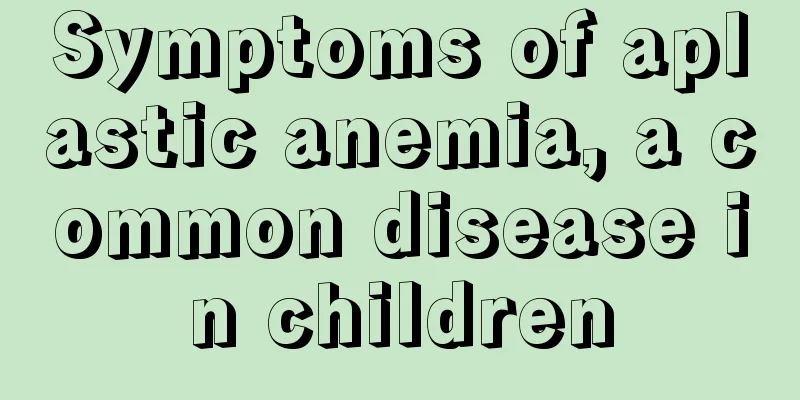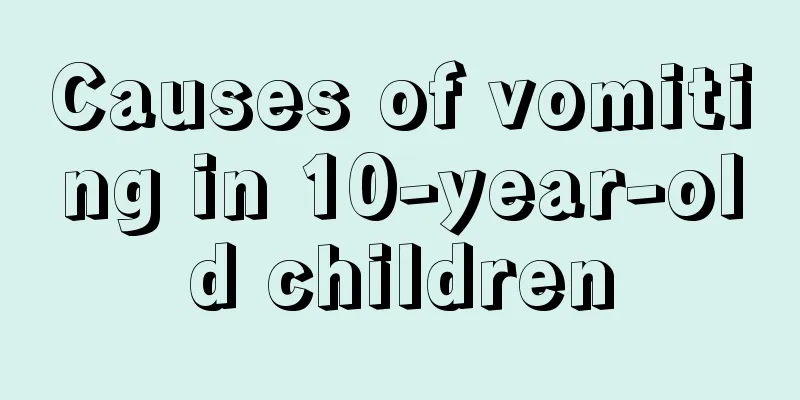Symptoms of aplastic anemia, a common disease in children

|
Aplastic anemia is common in children, and clinically presents with symptoms of hemorrhage, anemia, and infection. This disease is a problem with the bone marrow's hematopoietic function, which can be divided into acute and chronic, and a series of complications will also occur. 1. Acute aplastic anemia Acute aplastic anemia is characterized by rapid onset, rapid progression, and short course. Anemia is often not obvious in the early stage of the disease, but as the disease progresses, anemia progressively worsens, and there are often obvious fatigue, dizziness, palpitations and other symptoms. Even with massive blood transfusions, anemia is difficult to improve. Bleeding and infection are often the main symptoms at the onset of the disease. Almost every case has bleeding, and the bleeding site is extensive. In addition to surface bleeding such as skin, mucous membranes (oral cavity, nasal cavity, gums, and conjunctiva), there is often bleeding in deep organs, such as blood in the stool, hematuria, vaginal bleeding, fundus bleeding and intracranial hemorrhage. The latter is often life-threatening for patients. More than half of the cases have infection at the onset of the disease, with oropharyngeal infection, pneumonia, skin furuncle, intestinal infection, and urinary tract infection being more common. In severe cases, sepsis may occur. The most common pathogens are Escherichia coli, Pseudomonas aeruginosa, and Staphylococcus aureus. Infection often aggravates bleeding and often leads to death of patients. 2. Chronic aplastic anemia The characteristics of chronic aplastic anemia are slow onset, slow progression, and long course of the disease. Anemia is the first and main manifestation. Blood transfusion can improve anemia symptoms such as fatigue, dizziness, and palpitations. Bleeding is generally mild, mostly superficial bleeding such as skin and mucous membranes. Deep bleeding is rare. There may be mild infection and fever during the course of the disease, and respiratory infections are more common and easier to control. If the infection is severe and the high fever persists, it often leads to worsening bone marrow failure and transformation into severe aplastic anemia. 3. Aplastic anemia-related diseases (1) Paroxysmal nocturnal hemoglobinuria (PNH)/aplastic anemia: PNH and aplastic anemia are strongly associated with each other. The two diseases often occur simultaneously or successively in the same patient. They have similar clinical features, including pancytopenia and hypoplastic bone marrow. The disease has a regional tendency, with a high incidence in Asia. PNH is responsive to immunosuppressive therapy. PNH is characterized by intravascular hemolysis, venous thrombosis, and bone marrow hematopoietic failure. Many patients die from thrombosis rather than bleeding complications. (2) Hepatitis/aplastic syndrome: Aplastic anemia after acute viral hepatitis is not uncommon. Hundreds of cases have been reported so far. Among patients with aplastic anemia reported in the West, 2% to 9% had a history of hepatitis. The proportion may be higher in Asia. Although viral hepatitis can sometimes be accompanied by mild cytopenia, severe pancytopenia and hypoplastic bone marrow are uncommon. It is estimated that the proportion of childhood hepatitis is <0.07% and that of non-A, non-B hepatitis is 2%. Among patients with fulminant seronegative hepatitis leading to liver failure, 1/3 will eventually develop aplastic anemia. Aplastic anemia after hepatitis has the following characteristics: ① It often occurs within 1 to 2 months after viral hepatitis. Severe pancytopenia occurs during the recovery period of inflammation. Mild hematocytopenia may occur during the inflammatory period of viral hepatitis, such as granulocytes, thrombocytopenia, macrocytosis, atypical lymphocytosis, etc., similar to the manifestations of mild aplastic anemia. The prognosis is extremely poor, and the mortality rate within 1 year can reach 90%; ② The virus that causes post-hepatitis aplastic anemia is still unclear. Almost all studies have shown that the virus is non-A, non-B, non-C, and non-G hepatitis virus. It is common for patients with aplastic anemia to have combined hepatitis C and hepatitis G virus hepatitis, which is often believed to be caused by repeated blood transfusions rather than aplastic anemia. |
<<: How to treat amblyopia in children effectively
>>: Why are children's lips white? There are several reasons
Recommend
Four major misunderstandings about calcium supplementation for babies
When taking care of their babies, many mothers wi...
What causes children's memory loss?
In order to give their children a better future, ...
What to do if your child vomits after eating
It is a common phenomenon for children to vomit w...
What are the precautions for children’s dental beauty?
Orthodontic treatment for children is very common...
Why does the baby suck his fingers?
Care for the baby should be comprehensive. Many n...
What to do if a two-year-old baby sweats while sleeping at night
Babies are relatively weak, and it is normal for ...
What should I pay attention to when removing vernix caseosa from my baby’s labia?
Vernix caseosa refers to a type of fat that is pr...
Can children eat honey?
Honey is not only a delicacy that adults like, bu...
What are the diagnostic methods for rashes on children's necks?
We all know that children have been in a state of...
Why does the baby's nose turn blue and related suggestions
Every baby is loved by many people, such as mom, ...
Should newborns take medicine before or after feeding?
After being born, newborns are very susceptible t...
What should we pay attention to when infants grow and develop?
During the growth and development of infants, we ...
How many times a day is normal for a two-month-old baby to poop?
As parents of newborns, during the confinement pe...
What to do if your child has hemorrhoids
In people's minds, hemorrhoids are a common d...
What are the drugs that can enhance children's immunity?
Immunity is very important for children. If a chi...









